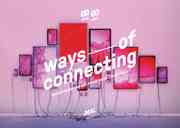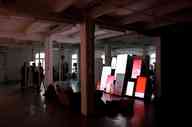Ways of Connecting
In April 2019, I curated at iMAL an exhibition featuring Evan Roth, Raphaël Bastide & Louise Drulhe.
The exhibition placed in conversation two pieces that reveal and translate in new forms the infrastructures and mechanisms underlying our connected environment. They were also related by their use of P2P web technologies, an alternative to the currently dominating model of centralised web.
Red Lines, by Evan Roth, is an online synchronised viewing experience of contemplative videos that evoke critical points of the internet infrastructure.
Renaming the Web, by Raphaël Bastide and Louise Drulhe is an installation illustrating the structure and fragility of the peer-to-peer computer network that forms it.
On 27 April, we organised a debate between Evan Roth and Raphaël Bastide, introduced and moderated by Sarah Grant (Radical Networks).
Curatorial statement
The metaphor of "the cloud" evokes something vaporous and intangible, both ubiquitous and unreachable. But the ethereal cloud actually relies on concrete infrastructures, grounded in a territory.
The web is worldwide thanks to kilometres-long submarine telecommunication cables interconnecting continents. These transatlantic connections are at the core of Evan Roth's Red Lines. Each played video "activates" the underwater link that connects us to the landscape currently displayed on screen.
Some of these cables still follow the routes of the British submarine telegraph system. Nicknamed "The All-Red Line", it somewhat traced the map of the British colonial empire1. Infrastructures are never entirely neutral.
Debates around the unbalanced power of the silicon valley, or around net neutrality also bring us back to infrastructures. There is a growing need for change that stimulates the emergence of alternatives, many of them leaning toward peer-to-peer decentralisation as a way to regain agency. Reflecting this time of crisis, the two exhibited pieces are both, in their own way, based on a peer-to-peer networks.
The purpose is however not documentary or pedagogical. There is instead a desire to reinterpret and translate our digital environment into more unexpected or subjective forms. Raphaël Bastide & Louise Drulhe defining themselves as "portraitists of these contemporary objects, revealing their characteristics in an attempt to understand them better"2.
-
See "What's Important About Underwater Internet Cables" by Ingrid Burrington, for The Atlantic ↩

